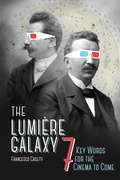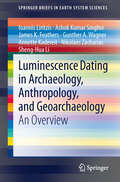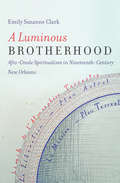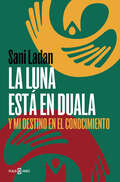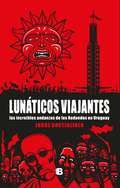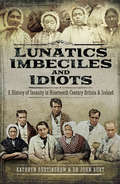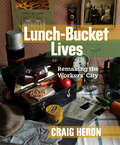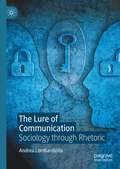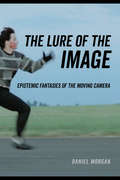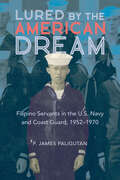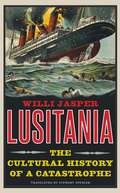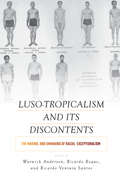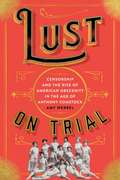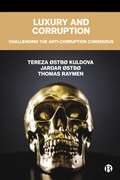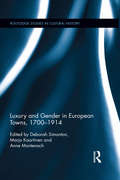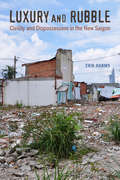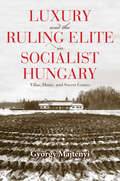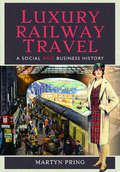- Table View
- List View
The Lumière Galaxy
by Francesco CasettiFrancesco Casetti believes new media technologies are producing an exciting new era in cinema aesthetics. Whether we experience film in the theater, on our hand-held devices, in galleries and museums, onboard and in flight, or up in the clouds in the bits we download, cinema continues to alter our habits and excite our imaginations.Casetti travels from the remote corners of film history and theory to the most surprising sites on the internet and in our cities to prove the ongoing relevance of cinema. He does away with traditional notions of canon, repetition, apparatus, and spectatorship in favor of new keywords, including expansion, relocation, assemblage, and performance. The result is an innovative understanding of cinema's place in our lives and culture, along with a critical sea-change in the study of the art. The more the nature of cinema transforms, the more it discovers its own identity, and Casetti helps readers realize the galaxy of possibilities embedded in the medium.
The Lumière Galaxy: Seven Key Words for the Cinema to Come (Film and Culture Series)
by Francesco CasettiFrancesco Casetti believes new media technologies are producing an exciting new era in cinema aesthetics. Whether we experience film in the theater, on our hand-held devices, in galleries and museums, onboard and in flight, or up in the clouds in the bits we download, cinema continues to alter our habits and excite our imaginations. Casetti travels from the remote corners of film history and theory to the most surprising sites on the internet and in our cities to prove the ongoing relevance of cinema. He does away with traditional notions of canon, repetition, apparatus, and spectatorship in favor of new keywords, including expansion, relocation, assemblage, and performance. The result is an innovative understanding of cinema's place in our lives and culture, along with a critical sea-change in the study of the art. The more the nature of cinema transforms, the more it discovers its own identity, and Casetti helps readers realize the galaxy of possibilities embedded in the medium.
Luminescence Dating in Archaeology, Anthropology, and Geoarchaeology: An Overview
by Annette Kadereit Ioannis Liritzis Sheng-Hua Li Rudolf Wagner Jim Feathers Nikolaos Zacharias Ashok SinghviThe field of Luminescence Dating has reached a level of maturity. Both research and applications from all fields of archaeological science, from archaeological materials to anthropology and geoarchaeology, now routinely employ luminescence dating. The advent of optically stimulated luminescence (OSL) techniques and the potential for exploring a spectrum of grain aliquots enhanced the applicability, accuracy and the precision of luminescence dating. The present contribution reviews the physical basis, mechanisms and methodological aspects of luminescence dating; discusses advances in instrumentations and facilities, improvements in analytical procedures, and statistical treatment of data along with some examples of applications across continents, covering all periods (Middle Palaeolithic to Medieval) and both Old and New World archaeology. They also include interdisciplinary applications that contribute to palaeo-landscape reconstruction.
A Luminous Brotherhood: Afro-Creole Spiritualism in Nineteenth-Century New Orleans
by Emily Suzanne ClarkIn the midst of a nineteenth-century boom in spiritual experimentation, the Cercle Harmonique, a remarkable group of African-descended men, practiced Spiritualism in heavily Catholic New Orleans from just before the Civil War to the end of Reconstruction. In this first comprehensive history of the Cercle, Emily Suzanne Clark illuminates how highly diverse religious practices wind in significant ways through American life, culture, and history. Clark shows that the beliefs and practices of Spiritualism helped Afro-Creoles mediate the political and social changes in New Orleans, as free blacks suffered increasingly restrictive laws and then met with violent resistance to suffrage and racial equality. Drawing on fascinating records of actual seance practices, the lives of the mediums, and larger citywide and national contexts, Clark reveals how the messages that the Cercle received from the spirit world offered its members rich religious experiences as well as a forum for political activism inspired by republican ideals. Messages from departed souls including Francois Rabelais, Abraham Lincoln, John Brown, Robert E. Lee, Emanuel Swedenborg, and even Confucius discussed government structures, the moral progress of humanity, and equality. The Afro-Creole Spiritualists were encouraged to continue struggling for justice in a new world where "bright" spirits would replace raced bodies.
La luna está en Duala: Y mi destino en el conocimiento
by Sani LadanLa conmovedora historia real de un adolescente que cruzó todo un continente para seguir estudiando. Imagina que vives en un país que no te permite realizar los estudios necesarios para desarrollarte como individuo. Imagina que no tienes mayor sueño que ese, precisamente. Trata de imaginar ahora que, con quince años, con la mente fría y despierta del adulto que proyectas ser y el corazón cargado de los secretos e ilusiones del niño que eres todavía, te escapas de casa sin más fin que conseguir un propósito que comienza a truncarse y a volverse violento y deshumanizante desde la primera parada en el camino. Esta historia, tan real como lo es la injusticia en el mundo en que vivimos, es la mía. «Me recuerdo tumbado, mirando al cielo. Incluso en esas circunstancias era imposible no apreciar la belleza de las estrellas y de la luna llena en un cielo tan limpio y despejado. Por mi mente desfilaban las imágenes de cada miembro de mi familia, de cada amigo. Conecté de nuevo con mi realidad, que había dejado atrás cuando vivimos el ataque de Boko Haram en Nigeria. En ese preciso momento quise tirar la toalla, volver a casa y reunirme con mis padres, pero lo cierto era que estaba en un lugar donde, por mucho que gritara, nadie me escucharía, salvo los que estaban conmigo, igual o peor que yo. Entonces me acordé de que a mi madre le encantaba contemplar la luna, sobre todo cuando está llena. En casa se ponía, a veces, un cubo con agua en el patio para observar el reflejo que la luna dejaba en su interior. Pensé que, en ese instante, mi madre podría estar contemplando la misma luna que yo, pero en casa, en Duala. Así que me puse a hablar con ella, o al menos eso creía, a través de la luna».
Lunatic Asylums in Colonial Bombay: Shackled Bodies, Unchained Minds (Mental Health in Historical Perspective)
by Sarah Ann PintoThis book traces the historical roots of the problems in India’s mental health care system. It accounts for indigenous experiences of the lunatic asylum in the Bombay Presidency (1793-1921). The book argues that the colonial lunatic asylum failed to assimilate into Indian society and therefore remained a failed colonial-medical enterprise. It begins by assessing the implications of lunatic asylums on indigenous knowledge and healing traditions. It then examines the lunatic asylum as a ‘middle-ground’, and the European superintendents’ ‘common-sense’ treatment of Indian insanity. Furthermore, it analyses the soundscapes of Bombay’s asylums, and the extent to which public perceptions influenced their use. Lunatic asylums left a legacy of historical trauma for the indigenous community because of their coercive and custodial character. This book aims to disrupt that legacy of trauma and to enable new narratives in mental health treatment in India.
Lunáticos viajantes: Las increíbles andanzas de Los Redondos en Uruguay
by Jorge CostiglioloA 20 años de su último recital en Montevideo conoceremos la historia, anécdotas y protagonistas de una relación de amor, pasión y rock and roll. Desde su nacimiento a fines de los años 70 en la de La Plata Patricio Rey y sus redonditos de ricota se convirtieron en un fenómeno cultural casi exclusivo de Argentina, salvo por Uruguay. Este libro repasa a través de testimonios, historias, anécdotas, mitos, verdades y leyendas las veces de cómo, cuándo y de qué manera Los Redondos se vincularon con Uruguay.
Lunatics, Imbeciles and Idiots: A History of Insanity in Nineteenth-Century Britain and Ireland
by Kathryn Burtinshaw Dr. John Burt&“Reveals the grisly conditions in which the mentally ill were kept . . . [and] harrowing details of the inhumane and gruesome treatment of these patients.&”—Daily Mail In the first half of the nineteenth century, treatment of the mentally ill in Britain and Ireland underwent radical change. No longer manacled, chained and treated like wild animals, patient care was defined in law and medical understanding, and treatment of insanity developed. Focusing on selected cases, this new study enables the reader to understand how progressively advancing attitudes and expectations affected decisions, leading to better legislation and medical practice throughout the century. Specific mental health conditions are discussed in detail and the treatments patients received are analyzed in an expert way. A clear view of why institutional asylums were established, their ethos for the treatment of patients, and how they were run as palaces rather than prisons giving moral therapy to those affected becomes apparent. The changing ways in which patients were treated, and altered societal views to the incarceration of the mentally ill, are explored. The book is thoroughly illustrated and contains images of patients and asylum staff never previously published, as well as first-hand accounts of life in a nineteenth-century asylum from a patient&’s perspective. Written for genealogists as well as historians, this book contains clear information concerning access to asylum records and other relevant primary sources and how to interpret their contents in a meaningful way. &“Through the use of case studies, this book adds a personal note to the historiography in a way that is often missing from scholarly works.&”—Federation of Family History Societies
Lunch-Bucket Lives: Remaking the Workers’ City
by Craig HeronLunch-Bucket Lives takes the reader on a bumpy ride through the history of Hamilton’s working people from the 1890s to the 1930s. It ambles along city streets, peers through kitchen doors and factory windows, marches up the steps of churches and fraternal halls, slips into saloons and dance halls, pauses to hear political speeches, and, above all, listens for the stories of men, women, youths, and children from families where people relied mainly on wages to survive. Heron takes wage-earning as a central element in working-class life, but also looks beyond the workplace into the households and neighbourhoods—settlement patterns and housing, marriage, child care, domestic labour, public health, schooling, charity and social work, popular culture, gender identities, ethnicity and ethnic conflict, and politics in various forms—presenting a comprehensive view of working-class life in the first half of the twentieth century. This book has been published with the help of a grant from the Federation for the Humanities and Social Sciences, through the Awards to Scholarly Publications Program, using funds provided by the Social Sciences and Humanities Research Council of Canada.
Lunch with the FT: A Second Helping
by Lionel BarberLunch with the FT has been a permanent fixture in the Financial Times for almost 30 years, featuring presidents, film stars, musical icons and business leaders from around the world.The column is now a well-established institution, which has reinvigorated the art of conversation in the convivial, intimate environment of a long and boozy lunch.This new and updated edition includes lunches with:Elon MuskDonald TrumpHilary MantelRichard BransonZadie SmithNigel FarageRussell BrandDavid GuettaYanis VaroufakisJean-Claude JunckerGwyneth PaltrowRebecca SolnitJordan PetersonChimamanda Ngozi AdichieAnd more...
The Lure of Communication: Sociology through Rhetoric
by Andrea LombardiniloThis book addresses the convergence of sociology, communication and rhetoric, with particular reference to the contemporary expressive and social patterns of mass communication. Using rhetoric as a meta-conceptual apparatus for the sociology of communication, this book offers an original and comprehensive critique of historical social theory alongside 20th century communication researchers. The author demonstrates the symbiotic relationship between the rhetorical structures of the media-sphere and the new narrative formats in which cultural representation merges into social and civil observation. This book will be of interest to academics and students studying sociology, communication and cultural studies.
The Lure of the Image: Epistemic Fantasies of the Moving Camera
by Daniel MorganThe Lure of the Image shows how a close study of camera movement challenges key assumptions underlying a wide range of debates within cinema and media studies. Highlighting the shifting intersection of point of view and camera position, Daniel Morgan draws on a range of theoretical arguments and detailed analyses across cinemas to reimagine the relation between spectator and camera—and between camera and film world. With sustained accounts of how the camera moves in films by Fritz Lang, Guru Dutt, Max Ophuls, and Terrence Malick and in contemporary digital technologies, The Lure of the Image exposes the persistent fantasy that we move with the camera within the world of the film and examines the ways that filmmakers have exploited this fantasy. In so doing, Morgan provides a more flexible account of camera movement, one that enables a fuller understanding of the political and ethical stakes entailed by this key component of cinematic style.
Lured by the American Dream: Filipino Servants in the U.S. Navy and Coast Guard, 1952-1970 (Asian American Experience)
by P. James PaligutanStarting in 1952, the United States Navy and Coast Guard actively recruited Filipino men to serve as stewards--domestic servants for officers. Oral histories and detailed archival research inform P. James Paligutan's story of the critical role played by Filipino sailors in putting an end to race-based military policies. Constrained by systemic exploitation, Filipino stewards responded with direct complaints to flag officers and chaplains, rating transfer requests that flooded the bureaucracy, and refusals to work. Their actions had a decisive impact on seagoing military’s elimination of the antiquated steward position. Paligutan looks at these Filipino sailors as agents of change while examining the military system through the lens of white supremacy, racist perceptions of Asian males, and the motives of Filipinos who joined the armed forces of the power that had colonized their nation. Insightful and dramatic, Lured by the American Dream is the untold story of how Filipino servicepersons overcame tradition and hierarchy in their quest for dignity.
Lusitania: The Cultural History of a Catastrophe
by Willi Jasper Mr Stewart SpencerA fascinating reassessment of a turning point in the First World War, revealing its role in shaping the German psyche On May 7, 1915, the Lusitania, a large British luxury liner, was sunk by a German submarine off the Irish coast. Nearly 1,200 people, including 128 American citizens, lost their lives. The sinking of a civilian passenger vessel without warning was a scandal of international scale and helped precipitate the United States' decision to enter the conflict. It also led to the immediate vilification of Germany. Though the ship's sinking has preoccupied historians and the general public for over a century, until now the German side of the story has been largely untold. Drawing on varied German sources, historian Willi Jasper provides a comprehensive reappraisal of the sinking and its aftermath that focuses on the German reaction and psyche. The attack on the Lusitania, he argues, was not simply an escalation of violence but signaled a new ideological, moral, and religious dimension in the struggle between German Kultur and Western civilization.
Luso-Tropicalism and Its Discontents: The Making and Unmaking of Racial Exceptionalism
by Warwick Anderson Ricardo Roque Ricardo Ventura SantosModern perceptions of race across much of the Global South are indebted to the Brazilian social scientist Gilberto Freyre, who in works such as The Masters and the Slaves claimed that Portuguese colonialism produced exceptionally benign and tolerant race relations. This volume radically reinterprets Freyre’s Luso-tropicalist arguments and critically engages with the historical complexity of racial concepts and practices in the Portuguese-speaking world. Encompassing Brazil as well as Portuguese-speaking societies in Africa, Asia, and even Portugal itself, it places an interdisciplinary group of scholars in conversation to challenge the conventional understanding of twentieth-century racialization, proffering new insights into such controversial topics as human plasticity, racial amalgamation, and the tropes and proxies of whiteness.
Lust in Translation: Infidelity from Tokyo to Tennessee
by Pamela DruckermanCompared to the citizens of just about every other nation, Americans are the least adept at having affairs, have the most trouble enjoying them, and suffer the most in their aftermath and Pamela Druckerman has the facts to prove it. The journalist's surprising findings include: Russian spouses don't count beach resort flings as infidelity South Africans consider drunkenness an adequate excuse for extramarital sex Japanese businessmen believe, "If you pay, it's not cheating."Voyeuristic and packed with eyebrow-raising statistics and interviews, Lust in Translation is her funny and fact-filled world tour of infidelity that will give new meaning to the phrase "practicing monogamy."
Lust on Trial: Censorship and the Rise of American Obscenity in the Age of Anthony Comstock
by Amy WerbelAnthony Comstock was America’s first professional censor. From 1873 to 1915, as Secretary of the New York Society for the Suppression of Vice, Comstock led a crusade against lasciviousness, salaciousness, and obscenity that resulted in the confiscation and incineration of more than three million pictures, postcards, and books he judged to be obscene. But as Amy Werbel shows in this rich cultural and social history, Comstock’s campaign to rid America of vice in fact led to greater acceptance of the materials he deemed objectionable, offering a revealing tale about the unintended consequences of censorship.In Lust on Trial, Werbel presents a colorful journey through Comstock’s career that doubles as a new history of post–Civil War America’s risqué visual and sexual culture. Born into a puritanical New England community, Anthony Comstock moved to New York in 1868 armed with his Christian faith and a burning desire to rid the city of vice. Werbel describes how Comstock’s raids shaped New York City and American culture through his obsession with the prevention of lust by means of censorship, and how his restrictions provided an impetus for the increased circulation and explicitness of “obscene” materials. By opposing women who preached sexual liberation and empowerment, suppressing contraceptives, and restricting artistic expression, Comstock drew the ire of civil liberties advocates, inspiring more open attitudes toward sexual and creative freedom and more sophisticated legal defenses. Drawing on material culture high and low, including numerous examples of the “obscenities” Comstock seized, Lust on Trial provides fresh insights into Comstock’s actions and motivations, the sexual habits of Americans during his era, and the complicated relationship between law and cultural change.
Lust und Abgrund: Theologische und kulturwissenschaftliche Zugänge zum Begehren (pop.religion: lebensstil – kultur – theologie)
by Richard Janus Harald Schroeter-WittkeDas Buch beleuchtet die Komplexe Lust, Begehren und Abgrund in popkulturellen Darstellungen aus theologischer und kulturwissenschaftlicher Perspektive.
Luttes paysannes en Colombie 1970-2016: Conflit agraire et perspectives de paix (Études en développement international et mondialisation)
by Leila CelisLa lutte pour la terre : voilà l’une des questions centrales du conflit en Colombie. Cette étude porte sur la logique et les actions des acteurs sociaux et armés dans cette lutte, et explore les conditions essentielles à la construction de la paix. Ce livre retrace l’évolution du mouvement agraire depuis les années 1970 en dégageant quatre phases ou dynamiques distinctes : autogestion, réclamation, résistance et autodétermination. Dans la première, les paysans luttent principalement pour la terre à travers la colonisation des terres publiques et l’occupation des terres de grands propriétaires. Dans la deuxième, ils se mobilisent pour revendiquer des investissements publics dans la vie et la production agricole. La troisième phase de la lutte paysanne correspond à la résistance juridique et aux déplacements intraterritoriaux devant la violence paramilitaire. Finalement, la quatrième phase correspond à la lutte actuelle contre l’extractivisme et pour l’autonomie territoriale. L’étude se base principalement sur l’histoire de l’Association nationale des paysans de la Colombie (ANUC), fondée en 1967, de la Fédération des paysans et des mineurs artisanaux du sud de Bolivar (FEDEAGROMISBOL), fondée en 1985, et de la Coordination nationale agraire (CNA), fondée en 1997. Ces organisations regroupent des paysans, petits et moyens propriétaires, dont la propriété n’est pas complètement légalisée et qui exploitent la terre dans des conditions précaires. Publié en français
Luxor And Its Temples
by A.M. BlackmanFirst published in 2005. Routledge is an imprint of Taylor & Francis, an informa company.
Luxury and Corruption: Challenging the Anti-Corruption Consensus
by Tereza Østbø Kuldova Jardar Østbø Thomas RaymenThe world has been bombarded in recent years with images of the luxurious lives and wealth of corrupt oligarchs and kleptocrats, amassed at the expense of ordinary people. Such images exploit our feelings of injustice, are taken as indicative of moral decay, and inspire a desire to purge our economies of dirty money, objects, and people. But why do anti-corruption efforts routinely fail? What kind of world are they creating? Looking at luxury art, antiquities, superyachts, and populist politics, this book explores the connection between luxury and corruption, and offers an alternative to the received wisdom of how we tackle corruption.
Luxury and Gender in European Towns, 1700-1914 (Routledge Studies in Cultural History)
by Deborah Simonton, Marjo Kaartinen and Anne MontenachThis book conceives the role of the modern town as a crucial place for material and cultural circulations of luxury. It concentrates on a critical period of historical change, the long eighteenth and nineteenth centuries, that was marked by the passage from a society of scarcity to one of expenditure and accumulation, from ranks and orders to greater social mobility, from traditional aristocratic luxury to a new bourgeois and even democratic form of luxury. This volume recognizes the notion that luxury operated as a mechanism of social separation, but also that all classes aspired to engage in consumption at some level, thus extending the idea of what constituted luxury and blurring the boundaries of class and status, often in unsettling ways. It moves beyond the moral aspects of luxury and the luxury debates to analyze how the production, distribution, purchase or display of luxury goods could participate in the creation of autonomous selves and thus challenge gender roles.
Luxury and Rubble: Civility and Dispossession in the New Saigon
by Erik HarmsA free ebook version of this title will be available through Luminos, University of California Press's open access publishing program for monographs. Visit www.luminosoa.org to learn more.Luxury and Rubble is the tale of two cities in Ho Chi Minh City. It is the story of two planned, mixed-use residential and commercial developments that are changing the face of Vietnam's largest city. Since the early 1990s, such developments have been steadily reorganizing urban landscapes across the country. For many Vietnamese, they are a symbol of the country's emergence into global modernity and of post-socialist economic reforms. However, they are also sites of great contestation, sparking land disputes and controversies over how to compensate evicted residents. In this penetrating ethnography, Erik Harms vividly portrays the human costs of urban reorganization as he explores the complex and sometimes contradictory experiences of individuals grappling with the forces of privatization in a socialist country.
Luxury and the Ruling Elite in Socialist Hungary: Villas, Hunts, and Soccer Games (Studies in Hungarian History)
by György MajtényiAfter World War II, a new community of elite emerged in Hungary, in spite of the communist principles espoused by the government. In Luxury and the Ruling Elite in Socialist Hungary, György Majtényi allows us a peek inside their affluence.Majtényi exposes the lavish standard of living that the higher echelon enjoyed, complete with pools, Persian rugs, extravagant furniture, servants, and groundskeepers. They shopped in private stores stocked with expensive meats and tropical fruits just for them. They benefited from access to everything from books, telephone lines, and international travel to hunting grounds, soccer games, and even the choicest cemetery plots. But Majtényi also reveals the underbelly of such society, particularly how these privileges were used as a way of maintaining power, initiating or denying entry to party members, and strengthening the very hierarchies that communism promised to abolish.Taking readers on a fascinating and often surprising look inside the manor homes and vacation villas of wealthy post–World War II Hungarians, Majtényi offers fresh insight into the realities of patriarchy, loyalty, gender, and class within the communist regime.
Luxury Railway Travel: A Social and Business History
by Martyn Pring&“Reads like an extravagant time travel through Britain&’s opulence era where train travel was just as stylish and fanciful as the elite class themselves.&” —Manhattan with a Twist Martyn Pring has carried out considerable research tracing the evolution of British luxury train travel weaving railway, social and travel history threads around a number of Britain&’s mainline routes traditionally associated with glamorous trains. Drawing on contemporary coverage, he chronicles the luxury products and services shaped by railway companies and hospitality businesses for Britain&’s burgeoning upper and middle classes and wealthy overseas visitors, particularly Americans, who demanded more civilized and comfortable rail travel. By Edwardian times, a pleasure-palace industry emerged as entrepreneurs, hotel proprietors, local authorities and railway companies all collaborated developing upscale destinations, building civic amenities, creating sightseeing and leisure pursuits and in place-making initiatives to attract prosperous patrons. Luxury named trains delivered sophisticated and fashionable settings encouraging a golden age of civilized business and leisure travel. Harkening back to the inter-war years, modern luxury train operators now redefine and capture the allure and excitement of dining and train travel experiences. &“Martyn&’s extraordinarily beautiful book is more than a collection of classic railway posters—it describes a way of life that&’s now lost in the mists of the twentieth century . . . As a piece of social history, this book is faultless, and a precious reminder of luxury and class distinction . . . [a] fabulous book. Exceptional.&” —Books Monthly &“A comprehensive account of luxury &‘hotel trains,&’ dining trains and the presentations of heritage railways brings the story to its unexpected conclusion . . . this is a lively take on a neglected topic.&” —BackTrack
